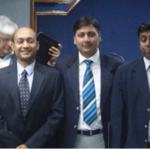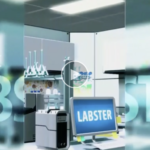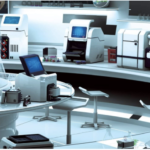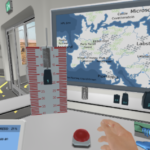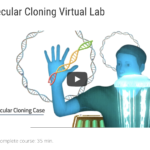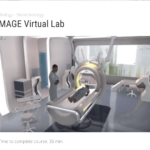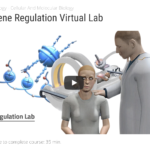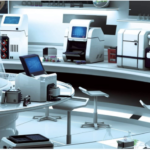Online Virtual and Mobile App Science & Engineering Labs
Hands-on experiential learning from Chile, India, and Denmark.
Quite often I hear that some things cannot be taught online. In most cases, this is not true. How can interactive hands-on experiences that students normally get from a laboratory or classroom lab be provided without physically going there? It’s not all that far-fetched. From Chile to India to Denmark, let’s see how.
Komal Dadlani was raised in Chile. She found that even at the university she attended the lab equipment wasn’t adequate enough for everyone run the experiment. In fact, Komal says that 88% of schools in Latin America do not have any lab equipment.
This drove the passion needed to create Lab4U, a mobile lab in your pocket. Taking advantage of the 5 billion smartphones around the world Lab4U is an inexpensive way to put science experimentation in the hands of learners everywhere.
Leveraging the built-in sensors of smartphones and tablets including the accelerometer, speedometer, and sonometer. these devices become powerful science labs with multiple instruments. Students can measure gravity or acceleration in real-time and so on.
Initial Pre- and Post-tests conducted to understand the effectiveness of using Lab4U versus traditional science education shows academic performance increased by an average of 34%.
Meanwhile, leaders at 12 higher education institutions in India are providing remote-access labs for various disciplines across Science and Engineering.
Virtual Labs, a name that says it all, caters to undergraduate and postgraduate students as well as research scholars. Labs are available for Computer Science; Engineering, Electrical, Mechanical, Chemical, and Civil Engineering, Biotechnology and Biomedical engineering, and more.
Soon to expand to South America, the Middle East and Africa, Labster is taking the world by storm. Several years ago, two university professors from Denmark were looking for innovative ways to capture the natural curiosity of students for learning science. They created virtual laboratory simulations. Grant funding drove the creation of Labster, now used by universities worldwide.
Fully interactive labs are combined with gamification elements such as an immersive 3D universe, challenges, storytelling and a scoring system. Mathematical algorithms enable open-ended investigations. Labster is a 24/7 state-of-the-art, million-dollar virtual lab in your browser with 100s of hours of science learning content. More than 60 simulations cover a wide range of subjects including Acids and Bases, Animal genetics, Antibodies, Bacterial Isolation, Crime scene investigations…Just to name a few.
The latest funding will enable further development of a simulation builder platform to allow students and scientists worldwide to create their own Virtual Reality simulations.
With creativity and ingenuity, it is amazing what can be taught online!
Three stellar examples of ways to properly study science online are uncovered from across the globe. From Chile where entrepreneurial students created a mobile lab in your pocket, to India where a partnership of universities fills the gap, to Denmark where a dream has turned into a million dollar lab in your browser, online virtual labs are providing hands-on experiential learning like never before.
LAB4U Science Lab from Chile
Students, teachers, and institutions from primary, secondary and tertiary institutions across Latin and South America are taking advantage of Lab4U. Most recently Lab4U has expanded their work to Mexico and the United States.
From Chile to Columbia to Argentina to Uruguay, what is all of the excitement about? You only need a smartphone or tablet as your scientific tools and the Lab4U apps.
Chilean, Komal Dadlani, a biochemist and graduate of the University of Chile, found her calling as a student when she became frustrated by the lack of hands-on experiential laboratory time. Partnering with fellow students, Alvaro Peralta and Isidro Lagos, Lab4U takes advantage of a smartphone’s built-in sensors.
Their idea was to put the ability to conduct labs directly into the hands of students without them needing any additional equipment beyond their smartphone. The labs are not virtually conducted with students at a distance from the tools but rather have them directly in their hands so learning can take place regardless of location.
Lab4U was jump-started a couple of years ago when these entrepreneurs won the grand prize in the 2014 Intel Global Challenge, receiving a $50,000 award from the Intel Foundation. This enabled them to create an inexpensive way to bring lab experiences into any teaching and learning environment.
Mobile Science Lab in Your Pocket
The team has developed the Lab4Physics mobile app so students can leverage various smartphone built-in tools. Students can measure gravity or acceleration in real-time with the built-in accelerometer. They can study speed, velocity, distance or displacement using the built-in speedometer. With the sonometer, students can study waves, amplitude, time and other physics phenomenon.
Coming soon, the Lab4Chemistry app will helps students learn spectrophotometric techniques. Students can use the built-in camera as a spectrophotometer or colorimeter to analyze samples wherever they may be. By taking pictures of droplets of different concentration and optical densities, they can create a calibration plot to measure a material’s transmission or reflection properties.
Each app has pre-designed experiments. For example, a student can swing their phone or tablet like a pendulum to learn how oscillation works.
Students and teachers alike can download the app, experiment, analyze and learn with pre-designed guided lab experiences and step-by-step instructions. For those who lack Internet access, the app experiments and tools can be downloaded to use offline, even in airplane mode.
Virtual Labs of India
Through an Initiative of Ministry of Human Resource Development (MHRD) under the National Mission on Education through ICT, twelve institutions of higher learning across India partnered to create Virtual Labs.
Their goal was to narrow the knowledge gap by providing equal opportunity and access. Virtual Labs enables remote experimentation, which addresses the lack of resources such as sophisticated instruments. The barrier of physical distance is removed. Students can study various disciplines of Science and Engineering and strengthen their skills without extra financial burden.
Anywhere from four to twenty-five labs are offered per discipline area. These areas include Computer Science & Engineering, Electrical, Mechanical, Chemical, and Civil Engineering, Biotechnology and Biomedical engineering, and more.
In any number of these Virtual Labs students uses one or a combination of modeling, measured data, and remote triggering.
For example, a Chemical Engineering student might learn about a Flow-through Venturi Meter in a lab offered by the National Institute of Technology, Karnataka (NITK). The lab provides the background and theory, a procedure and simulation, a self-evaluation, and is supported by references and videos.
Virtual Labs caters to students at the undergraduate level and postgraduate level as well as to research scholars.
Virtual Labs Simulations from Denmark
Several years ago, a tech entrepreneur and a Dr. of biotechnology from Denmark, Mads Tvillinggaard Bonde and Michael Bodekaer, were seeking a better way to stimulate students’ natural curiosity. They became inspired by the power of flight simulation and decided to apply the concept to science.
Having already received more than $10 million in grant funding, their vision quickly grew into Labster, a company headquartered in Copenhagen, Denmark, with offices in Bali, Zurich, London, and most recently, Boston.
 Now used by universities worldwide, these fully interactive advanced labs combine gamification elements such as an immersive 3D universe, challenges, storytelling and a scoring system with mathematical algorithms enable open-ended investigations. Easily accessible, each is based on research in the psychology of learning.
Now used by universities worldwide, these fully interactive advanced labs combine gamification elements such as an immersive 3D universe, challenges, storytelling and a scoring system with mathematical algorithms enable open-ended investigations. Easily accessible, each is based on research in the psychology of learning.
Hands-on Experiential Lab in Your Browser
Labster currently has more than 60 simulations covering a wide range of topics including Parkinson’s Disease, Viral Gene Therapy, Eutrophication, Lab Safety, Animal Genetics, Tissue Engineering, and Waste Water Treatment, just to name a few. Some simulations are available in virtual reality. The addition of a VR headset gives a fully immersive experience.
Labster has partnered with an extensive list of top-tier universities including Imperial College, The University of Melbourne, MIT, Berkeley and Cambridge and has customers across 25 countries from ETH in Zurich and the University of Hong Kong to Stanford and Harvard Medical School.
All that is needed is a computer or laptop and a browser to perform advanced experiments and achieve core science learning outcomes. It is like having a million dollar lab in your browser. Even older computers can run the simulations and don’t require installations of any plugins.
Labster is developing LabBuilder, a tool that enables teachers, students, and researchers to develop their own 3D virtual lab simulations to test scientific problems and hypotheses. Even Greater things are expected to come soon. Indeed, Labster is one to keep an eye on.









